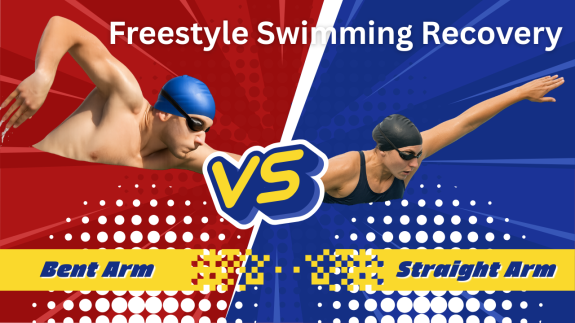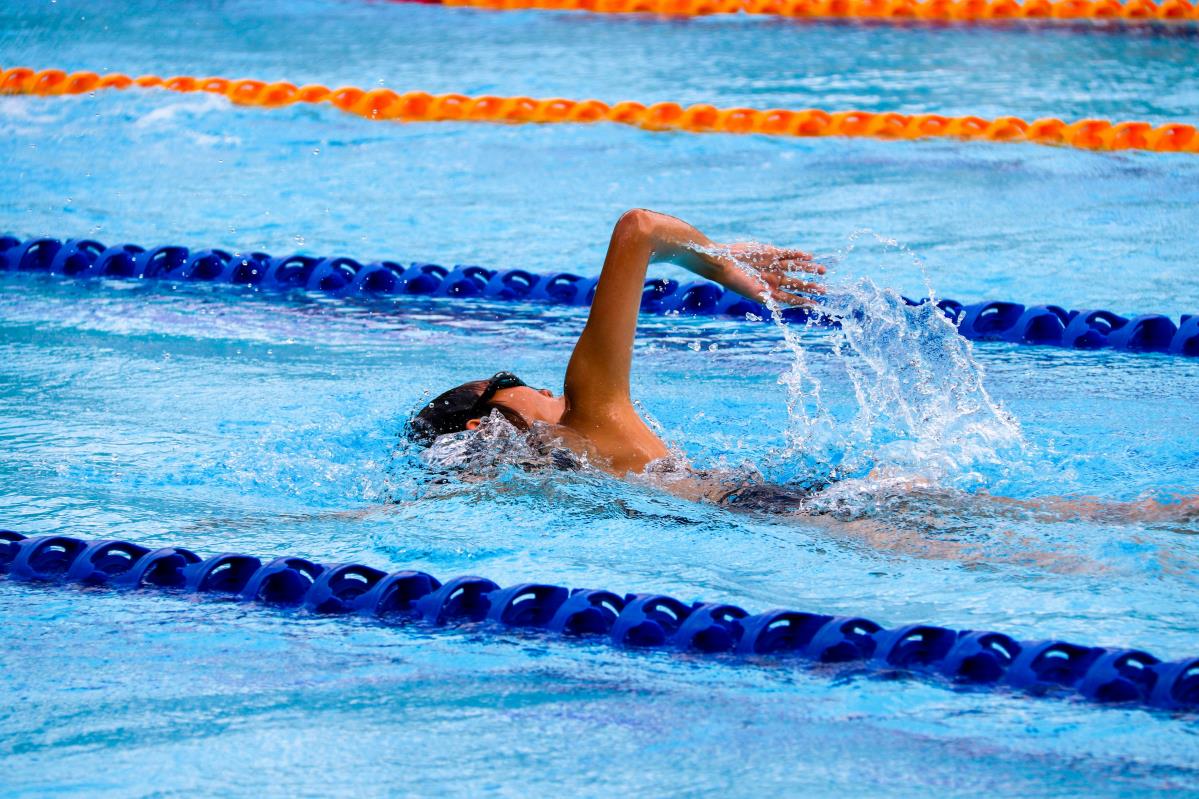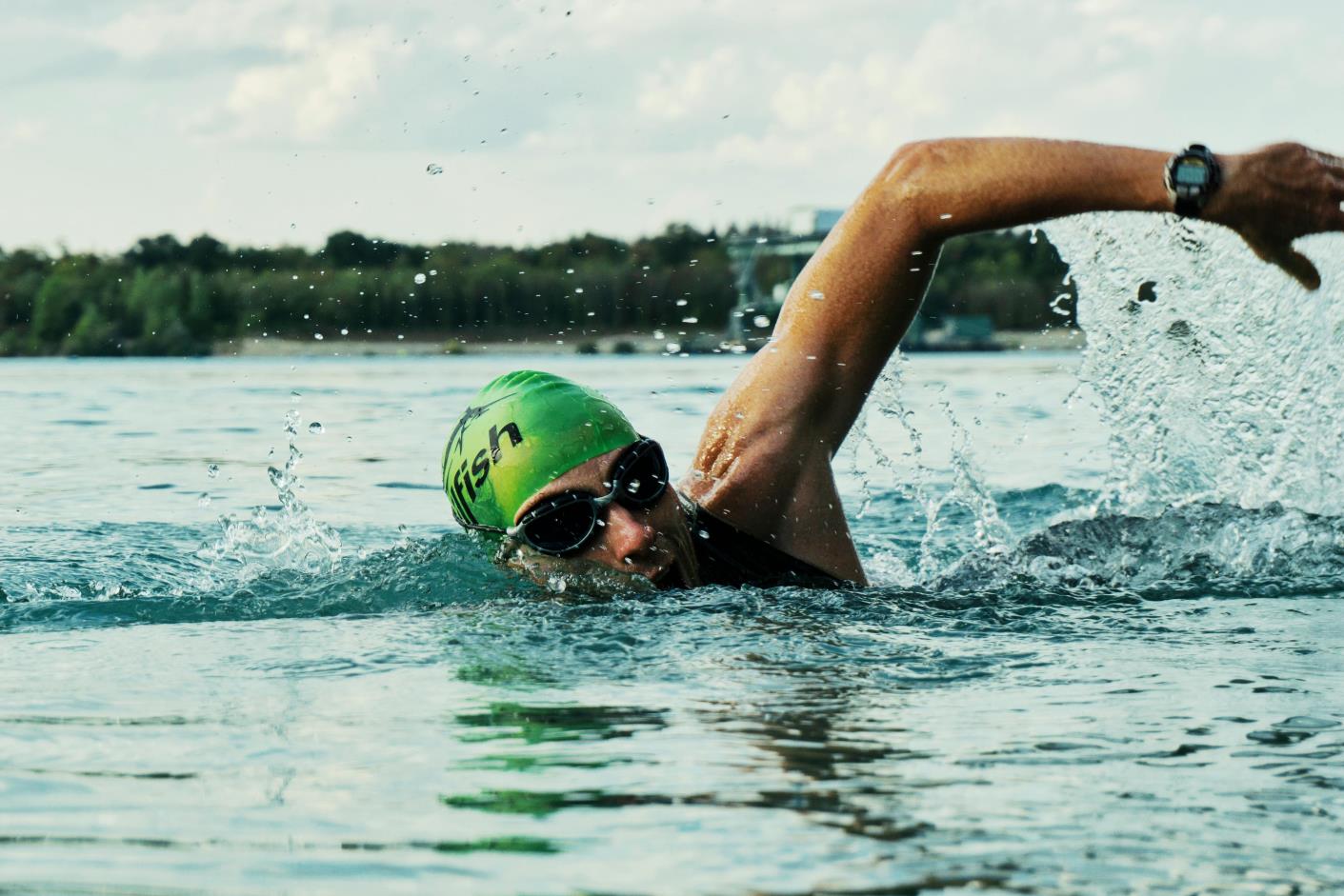Bent Arm vs Straight Arm Recovery in Freestyle Swimming: Which is Best for You?
 Karen Parnell
June 17, 2025
Karen Parnell
June 17, 2025
Bent Arm vs Straight Arm Recovery in Freestyle Swimming: Which is Best for You?
As a triathlon coach with years of experience helping athletes of all levels improve their swim technique, I often get asked: "Should I swim with a bent arm recovery or a straight arm recovery?" The short answer is: it depends.
Let me walk you through the differences, the pros and cons of each, and how to decide which is best for you, especially in the context of open water swimming and shoulder mobility.
If you prefer to listen to Blogs you can listen to it here:

Get your FREE Swim Workouts for Triathletes E-book
Understanding the Difference Between Bent and Straight Arm Recovery
Before you can decide which recovery style suits you best, it’s important to understand what sets them apart. While both high elbow (bent arm) and straight arm recovery are used by elite swimmers, they serve different purposes and place different demands on the body.
This section breaks down the mechanics of each technique so you can recognize them in action—and start to understand how they impact stroke rhythm, power, and fatigue, particularly in the context of triathlon and open water swimming.
Bent Arm or High Elbow Recovery
This traditional freestyle technique involves keeping the elbow bent and elevated above the wrist and hand during the recovery phase (the part of the stroke when your arm comes out of the water and moves forward to re-enter). The elbow leads the recovery, and the hand stays close to the water as it moves forward and. It’s probably what you learned in your early swimming lessons.
Video: Bent Arm Recovery
Get your FREE Swim Workouts for Triathletes E-book
Straight Arm Recovery
Here, the arm is kept mostly straight during recovery, swinging around the side in a wider arc. This style is commonly seen in elite open water and triathlon swimmers.
Video: Straight Arm Recovery
Get your FREE Swim Workouts for Triathletes E-book
Pros and Cons of Each Recovery Technique
Each recovery style offers unique advantages and challenges. Understanding the pros and cons of high elbow and straight arm techniques can help you choose the best fit for your goals, anatomy, and race conditions.
Bent Arm Recovery
Pros:
- It keeps your stroke more linear so the hand path from the back to the front in a straight line which can minimise lateral movement which could cause “snaking” or drag.
- Can help maintain good body alignment and balance due to its linear trajectory.
Cons:
- Requires good shoulder mobility to execute properly.
- Can be difficult to maintain under fatigue.
- Can be difficult to learn to do efficiently.
- May encourage a lazier, slower freestyle with less body rotation.

Get your FREE Swim Workouts for Triathletes E-book
Straight Arm Recovery
Pros:
- Excellent for power and speed, especially in choppy open water.
- Promotes quicker turnover rate (stroke frequency).
- Can feel more relaxed and easier to learn.
- Easier to execute for swimmers with limited shoulder mobility as it doesn't demand as much internal rotation.
- Can help you get more shoulder and whole-body rotation which is beneficial in freestyle/front crawl swimming.
- Good option for swimmers with limited proprioception or who started swimming later in life.
Cons:
- More physically demanding; can tire the shoulders and upper body faster
- Can lead to poor alignment if not controlled properly
Coaches Tip: On both styles it’s important to not cross the mid-line as your hand enters the water. Ideally your hand placement into the water should be in line with your shoulder and fully extended to maximise your reach.

Get your FREE Open Water Swimming Sessions E-Book
Open Water vs Pool Swimming
For open water, many elite triathletes opt for a straight arm recovery. It allows a more aggressive, powerful stroke that can cut through waves and help with navigation (your hand travels higher, aiding sighting). Additionally, the increased turnover helps you stay competitive in the pack.
In a pool setting, especially for long-distance training, a bent elbow recovery is usually better. It conserves energy and encourages a smoother, more sustainable rhythm.
Shoulder Mobility Considerations
If you struggle with shoulder flexibility or have a history of impingement or injury, a straight arm recovery might feel more natural and cause less discomfort. While there is limited direct research comparing recovery styles, studies show that swimmers often experience decreased shoulder external rotation and scapular control with high-volume training (Madsen et al., 2011), and altered mechanics can impact recovery comfort and efficiency.
Additionally, biomechanical analyses (e.g., Prins & van Heerden, 2017) suggest that a straight arm recovery may reduce shoulder impingement in swimmers with limited internal rotation by avoiding excessive shoulder elevation and internal rotation during recovery.
Some literature and videos confuse a straight arm recovery with a straight arm pull under the water. A straight arm pull under the water is not advised as this can indeed cause shoulder injuries.
So, when your arm has little resistance i.e. in air over the water then a straight arm can be performed and when your arm has more resistance i.e. in water then a bent arm is advisable.
However, that doesn't mean you should never work on your mobility. Improving your range of motion through targeted stretching and strength work can help you perform both techniques more effectively.
Here’s a great mobility routine for swimmers that you can do after your swim session or at any time during the week to work on your swimming mobility:
Get your FREE Mobility Challenge
Keys to Doing Each Recovery Method Well
Mastering either recovery style requires more than just knowing what it looks like — it’s about developing the body awareness, rhythm, and technical precision to execute it effectively under pressure. Whether you're refining a relaxed high elbow recovery for distance or powering through with a straight arm in rough open water, small adjustments in form can make a big difference in efficiency and performance. Below are the key elements to focus on for each style to ensure you’re getting the most out of your stroke plus some suggested drills to help you perfect your recovery.
Bent Elbow Recovery Method
- Lead with your elbow, not your hand
- Keep the recovery relaxed and smooth
- Rotate your body to allow natural arm motion
- Avoid crossing over the centreline on hand entry
Bent or High Elbow Recovery Drills
To help you master the bent or high elbow recovery here are some suggested swimming drills.
1. Fingertip Trail Drill
Purpose: Promotes relaxed, high elbow movement and awareness of elbow position.
- How to do it: As you recover your arm over the water, drag your fingertips across the surface from exit to entry.
- Focus cue: Keep your elbow high, hand relaxed, and movement smooth.
- Common mistake: Lifting the entire arm or rotating the body excessively—keep movement soft and natural.
Get your FREE Open Water Swimming Sessions E-Book
2. Zipper Drill
Purpose: Builds muscle memory for elbow-driven recovery.
- How to do it: Imagine zipping up a wetsuit along your side. As you recover, slide your thumb up along your torso to your armpit, elbow pointing upward.
- Focus cue: Lead with your elbow, keeping it above your hand the entire time.
Get your FREE Swim Workouts for Triathletes E-book
Straight Arm Recovery Method
- Engage your core to stabilize during the recovery arc
- Don’t swing too far out or across
- Keep a strong and fast rhythm, especially in rough water
- Use the momentum to set up a powerful catch
Drills for Straight Arm Recovery
To help you perfect a straight arm recovery here are some drills you can try.
1. Straight Arm Over-Recovery Drill
Purpose: Reinforces the circular arc and body coordination needed for straight arm recovery.
- How to do it: Swim normally but exaggerate the recovery by keeping the arm fully extended, swinging it wide and around.
- Focus cue: Keep the arm firm, use body rotation to assist the movement, and don’t over-rotate the torso.
Get your FREE Open Water Swimming Sessions E-Book
2. Water Polo Drill
Purpose: Develops straight-arm recovery and high hand clearance.
- How to do it: Swim freestyle with your head out of the water (like a water polo player). Recover with a straight arm, clearing the hand over the water line.
- Focus cue: Engage core and lats to stabilize, keep stroke rate high.
Get your FREE Swim Workouts for Triathletes E-book
Integration Tip: Contrast Drills
To build awareness, alternate 25 meters of high elbow recovery with 25 meters of straight arm recovery. This will help you feel the mechanical differences and choose the appropriate style for different race situations. It will also help you decide which style is best for your biomechanics.
Conclusion and Final Thoughts
There's no one-size-fits-all answer. Many triathletes even blend the two styles depending on the situation: using high elbow recovery for drills and base training and switching to straight arm during races or intervals. Some swimmers may even have a bent elbow on one side and straight arm recovery on the other!
The key is to experiment and listen to your body. If you're unsure, video yourself swimming and analyse your form—or better yet, work with a coach.
I offer a remote swim stroke video analysis, and you can find details on this page.
If you have shoulder issues or are preparing for an open water race, lean towards the straight arm. If you're building aerobic endurance or focusing on technique, high elbow might serve you better.
Karen Parnell is a Level 3 British Triathlon and IRONMAN Certified Coach, 8020 Endurance Certified Coach, WOWSA Level 3 open water swimming coach and NASM Personal Trainer and Sports Technology Writer.
Karen has recently completed a postgraduate MSc in Sports Performance Coaching at the University of Stirling.
Need a training plan? I have plans on TrainingPeaks and FinalSurge:
I also coach a very small number of athletes one to one for all triathlon and multi-sport distances, open water swimming events and running races, email me for details and availability. Karen.parnell@chilitri.com
Get your FREE Guide to Running Speed and Technique
Get your FREE Swim Workouts for Triathletes E-book
Get your FREE Open Water Swimming Sessions E-Book
References
Madsen, P., Bolgla, L., and Uhl, T., 2011. Scapular kinematics and muscle activity during functional tasks in swimmers with and without shoulder impingement symptoms. Journal of Sport Rehabilitation, 20(3), pp.333–345.
Prins, J.H. and van Heerden, J.H., 2017. Biomechanical considerations in the prevention and treatment of swimmer’s shoulder in competitive swimmers. South African Journal of Sports Medicine, 29(3), pp.1–6. doi:10.17159/2078-516X/2017/v29i3a468.
Frequently Asked Questions (FAQ) for Bent verus Straight Arm Recovery
1. Which recovery style is better for triathlons?
Both can work, but many triathletes favor straight arm recovery in open water for its power and higher hand clearance in waves. For training or calmer races, high elbow recovery may be more energy-efficient.
2. Can I switch between styles during a race?
Absolutely. Some athletes use high elbow recovery during calm stretches and switch to straight arm in rougher conditions or during sprint finishes.
3. Does straight arm recovery cause shoulder injuries?
Not inherently. When done with proper technique and body rotation, it can be safe. However, it places greater demand on the shoulders and requires strength and conditioning to support it.
4. How do I know if my shoulder mobility is limiting my stroke?
If you feel discomfort or can’t comfortably raise your arm overhead or behind your back, mobility may be restricted. A coach or physio can help assess this.
5. Is high or bent elbow recovery outdated?
Not at all. It remains the go-to for many distance swimmers and is excellent for conserving energy and maintaining balance—especially in pool-based training.
6. Which style is more energy-efficient?
High elbow recovery is generally more efficient for long distances, while straight arm recovery prioritizes speed and turnover, making it better suited for sprints and rough water.
